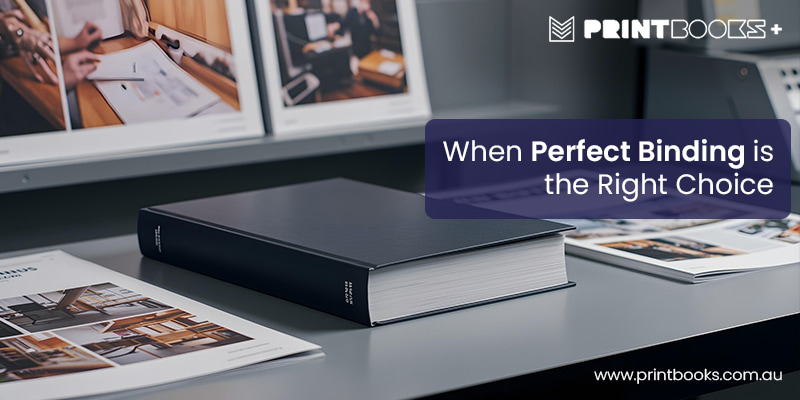When and Why to Choose Perfect Book Binding for Your Project

First impressions last longer than words on a page. A project is remembered not just for its content but for how it is presented. Even the most brilliant ideas can lose impact if the pages feel loose or the spine weakens after a few uses. Poor binding makes strong content look temporary and the effort behind it is easily overlooked.
Perfect book binding changes that outcome entirely. It’s not just a matter of glue holding pages together—it’s a method that adds credibility and even character to the message within. When chosen wisely, perfect binding elevates a project from being “just another document” to a piece that commands attention and respect.
Let’s explore why and when this type of binding becomes the right choice for projects that truly matter.
What Makes Perfect Binding Different
Perfect binding gives a clean and sharp look that instantly elevates any project. It creates a flat spine that can hold text or logos unlike spiral or staple binding. This means when placed on a shelf the book does not just disappear—it stands out. This feature alone makes it an attractive choice for projects that need to look professional.
Another unique detail is the way it handles larger volumes. While some binding methods work best for slim documents, perfect binding comfortably holds thicker manuscripts. It feels sturdy in the hands yet is not bulky which makes it easy to carry and store.
When Perfect Binding is the Right Choice

Perfect binding works beautifully when the project has more than 40 pages. That’s when the spine gets the right thickness to look strong and professional. Imagine handing over a catalog of your brand, a thesis for your degree or a portfolio of your creative work. The impression falls short if it feels flimsy. But with perfect binding the weight and polish create the sense that the work is valuable and worth keeping.
This method is also a natural choice when the goal is presentation. Annual reports, magazines, product guides—all of these benefit from a finish that looks refined and feels dependable. No one wants to flip through something that looks like it could fall apart after a few uses. Perfect binding makes sure that does not happen.
The Balance Between Durability and Elegance
One of the best features of perfect binding is the balance it offers. Hardcover binding feels too heavy for many uses while spiral binding sometimes feels casual. Perfect binding sits right in the middle as it will be strong enough to last but still light and practical.
Take magazines as an example. They need to be attractive enough to catch attention and durable enough to handle repeated flipping. That’s why many publishers prefer perfect binding as it holds everything together neatly without sacrificing design appeal.
A First Impression That Lasts
Here’s a small truth: people notice the way a book looks before they read a single word. The cover, the spine, the finish—these all create the first impression. Perfect binding makes sure that impression is sharp and professional.
Picture walking into a meeting with two reports. One is stapled loosely; the other is neatly perfect bound with a glossy cover and printed spine. Most people will see the second one as more credible without even opening them. That’s the kind of difference this binding style can make.
Cost Without Compromise
Another reason many choose perfect binding is its affordability compared to hardcover. It gives a premium look without stretching the budget. For medium to large projects, this method offers real value because it balances cost with a professional finish. This is why businesses, authors and students often lean toward it—it feels high quality but does not carry the heavy price tag of more elaborate methods.
Usability That Adds Value
Perfect binding is not just about appearance. It is also about how comfortable it feels to use. The cover can be customized with designs thus making it look like a finished product ready for a bookstore or a boardroom.
Perfect binding keeps everything smooth and intact unlike spiral binding which sometimes snags or bends. That little detail makes it more practical for people who want something they can flip through many times without damage.
When Perfect Binding May Not Work
Of course, this method is not suitable for every project. If the document is too thin—say fewer than 30–40 pages—the spine would not have enough width to hold the glue properly. Also, if the project needs to lie flat when open spiral binding might be more convenient. But for most substantial projects, perfect binding becomes the clear choice.
Why the Choice Matters
Choosing a binding style might feel like a small detail but it’s actually one of the most important finishing touches. Perfect binding adds weight to the effort behind a project.. When a book looks polished, people naturally assume the content inside carries the same level of care.
So, when the aim is to impress and be remembered then perfect binding is worth considering. It does not just secure pages; it secures the reputation of the work.
Final Reflection
Every project deserves a presentation that does justice to the effort behind it. Perfect binding creates that final polish. This method gives the work the respect it deserves.
In the end, the choice of binding is not just a technical step. It is part of the story the project tells. Perfect binding ensures that story looks as valuable on the outside as it is on the inside. Cool, right?
